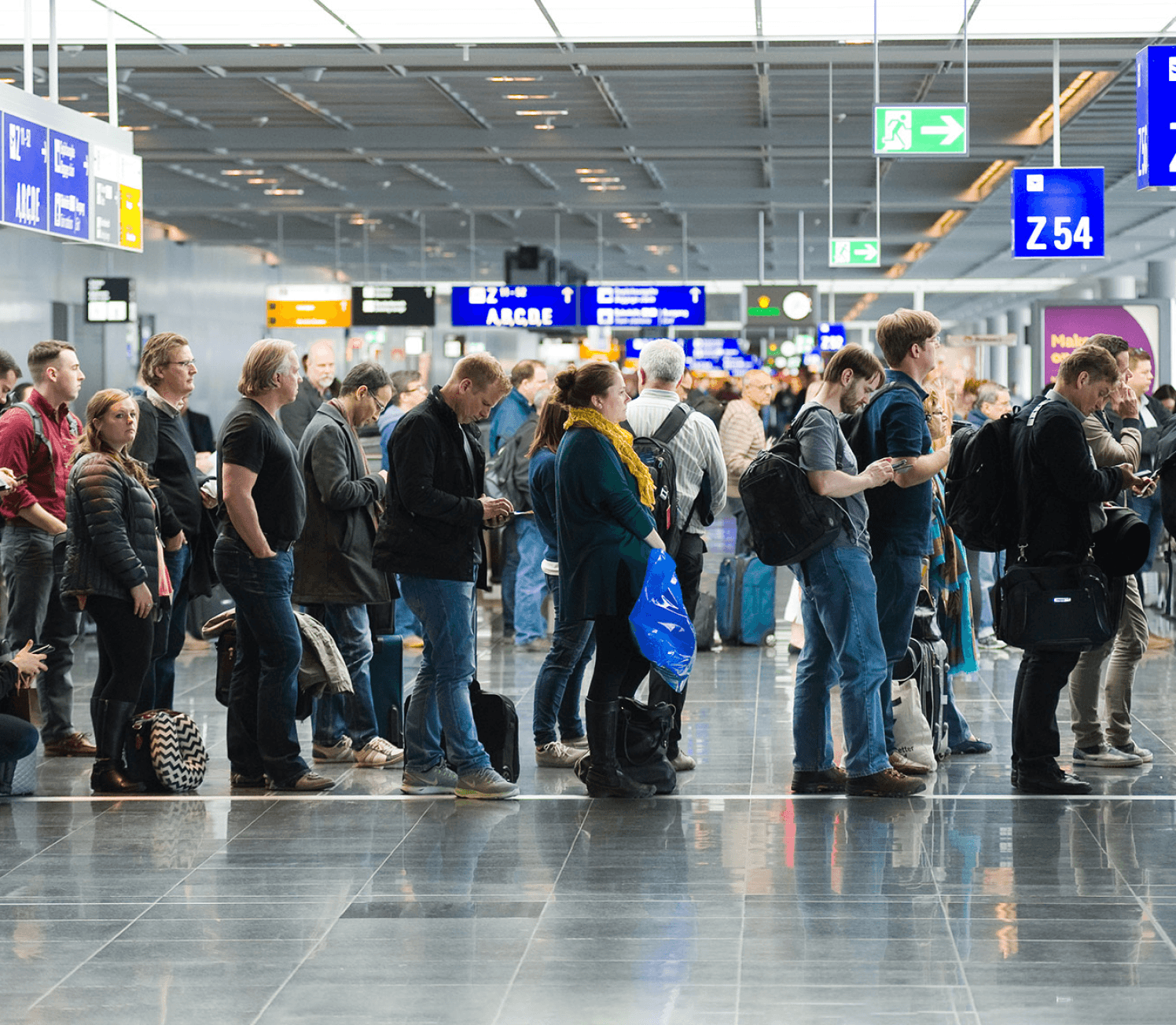Crafting the Future of Travel
In 2018, more than 57,000 travelers missed their flights due to outdated airport security protocols. This led to significant disruptions for airlines and immense frustration for passengers. The need for improved and more secure travel processes became glaringly apparent. To address this issue, I’m hired as a freelance product designer for Idemia.

A Systemic Global Challenge
Airports around the world are bracing for an unprecedented surge in travelers—over 8.2 billion annually by 2037, according to IATA. This isn’t just about long lines or slow checkpoints. It’s about the strain on entire national infrastructures, from immigration to biometric systems, across dozens of jurisdictions. The solution isn’t a faster scanner—it’s a better experience, designed to be secure, respectful, and seamless at a global scale.




Building Empathy Without Access
Working without direct user access, we needed another way to understand what travelers actually go through at security checkpoints. I pieced together their journey by studying process charts, online traveler forums, and behavioral patterns in high-pressure public systems. The storyboard we created wasn’t built from quotes, but from careful reconstruction of what users feel: time pressure, confusion, and privacy concerns. These sketches became emotional anchors for the interface work that followed.

Reframing for Alignment and Integration
As an external product designer collaborating with Idemia, I worked within an established ecosystem of security solutions—spanning mobile identity (MID), identity sharing (ID Way), multimodal biometrics (IBRS), and identity proof repositories (IPRS). Rather than reinventing, my role was to seamlessly align with the existing product architecture, tone, and interface patterns. By embedding design work into their current structure, I was able to contribute visual clarity and usability improvements without disrupting internal consistency or established workflows—delivering value through adaptation, not overhaul.



Before flight check-in
The DTC App makes it possible to quickly generate your digital traveling passport.
You’re empowered to digitalize your passports within minutes.
The DTC App makes it possible to quickly generate your digital traveling passport.
The DTC App makes it possible to quickly generate your digital traveling passport.
The DTC App makes it possible to quickly generate your digital traveling passport.
Quickly scan the passport
Immediately tap passport
Get your DTC immediately
Enter identity by face verification
Scan the Passport MRZ
Back
MRZ are the lines of characters located at the bottom of your passport data page
Start scan
Wallet
Scan
Requests
More
Hi Lilian
Your DTC is here
Passport NDL
Document number
AX12345678
Status
Active

View Details
Total Document ID:
1
New
Current ID
Airline Loyalty

United Airlines

American Airlines

Hawaiian Airlines

JetBlue Airways
Process Overview and the highlights
Kickoff
User Interview
Brainstorming
First Pitch
Low-fidelity Mockups
High-fidelity Mockups
Iteration
Second Pitch
Micro Interaction
User Testing

Understanding Through Existing Research
Given the constraints of working in a high-security domain, we turned to existing studies and industry reports to understand traveler pain points. By reviewing airport UX case studies, IATA reports, and biometric flow analysis, we identified recurring moments of stress and delay—particularly around ID submission and checkpoint procedures. These insights helped shape a design approach grounded in real-world constraints.
- Long waiting times were a major source of frustration.
- The manual checking process often led to errors and delays.
- There was a strong preference for digital solutions that could streamline the experience.
"Airport security is a nightmare! I spend more time in line for those checks than actually in the flight. It's beyond frustrating."
"The whole security process feels like a joke. I never thought I'd spend hours just waiting to get through a checkpoint. It's infuriating."
"There's got to be a better way to ensure safety without making travelers endure endless lines and waiting. The frustration is real."
"It's like they want us to arrive at the airport days in advance. The security checks take forever, and there's no end to the frustration."
"Security checks are the bane of my travel experience. It's like they actively try to make it as frustrating as possible. Something needs to change."
"The inefficiency of airport security is mind-boggling. I can't wrap my head around why it takes so long just to get through a checkpoint."

"I just want to get to my destination without feeling like I've run a gauntlet. The constant frustration with airport security is exhausting."
Collaborative Ideation, Remotely
Working across time zones and disciplines, we began the project with a remote ideation sprint. Each contributor shared low-fidelity sketches asynchronously—via Miro boards, screenshots, and quick screen recordings—to explore divergent ideas for the same user flow. I consolidated recurring patterns and facilitated structured critique sessions to converge on a unified wireframe direction. This lightweight, distributed sketching process helped us spot edge cases early and align on interaction priorities before committing to visual polish.


Fill passport by scanning
Scan Visa
Airport waiting time
Face verification

Leveraging Constraints as Design Catalysts
Rather than treating legal and technical constraints as barriers, we used them as creative triggers to reimagine how identity data could flow. Through close collaboration with engineering and compliance teams, we explored how smart sequencing, edge processing, and data minimization could enable a more fluid user experience without compromising regulation. This approach allowed us to turn necessary steps—like early-stage ID verification—into strategic UX moments, letting the technology lead where it could, and deferring where it must.
conclusion
The development of the Digital Travel Credential represents a significant step forward in modernizing airport security and improving the travel experience. By embracing innovation and addressing key pain points, we have crafted a solution that not only meets the needs of today's travelers but also prepares for the future demands of the aviation industry.